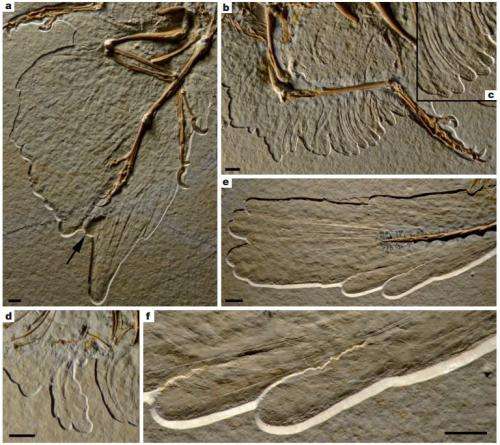New fossil shows Archaeopteryx sported 'feathered trousers'

The origin of feathers and the origin of flight have been a contentious chicken-and-egg issue in the scientific world for decades. Did feathers develop as a flight mechanism - or were they first used for other purposes?
Now, the discovery of an Archaeopteryx skeleton with feathered "trousers" bolsters the idea that these feathers weren't for flying and initially may have been used as impressive displays. The findings in the journal Nature shed light on the complex evolution of feathered flight.
Archaeopteryx, which lived in the late Jurassic period roughly 150 million years ago, is considered a transitional species, sharing many characteristics of both dinosaurs and modern birds. The handful of skeletons and their fossilized feather impressions - sometimes poorly preserved - have led to various ideas about how this dinosaur lived. Some say its feathers were used for flight, others argue that their plumage was primarily for showing off to potential mates. Some saw feathers on the animals' hind limbs and proposed that Archaeopteryx was a four-winged glider, using both pairs of limbs to soar through the air.
Now, a team of German scientists have examined a remarkably well preserved specimen and found different kinds of feathers covering different parts of its body. It boasts long, 4- to 4.5-centimeter feathers on its hind limb, which are more than half the length of the tibiotarsus leg bone. But in a blow to the four-winged theory, the feathers were symmetrical on either side of their stems, making them less useful for flight. Aerodynamic feathers used for flight are asymmetrical, with one side narrower and the other wider (looking a little like wings themselves).
"These results contradict the hypothesis that the flapping flight of modern birds was preceded by a four-winged gliding stage," the study authors wrote.
On the other hand, the tail feathers were much longer, from 9.9 to 11.4 centimeters long and more than half the length of the bony tail. They were also asymmetrical, which could mean the tail feathers had "a secondary aerodynamic function," used to increase the animal's total lift.
The researchers also looked at the evolution of feathers in other related dinosaurs, cataloging what kinds of feathers they sported. It turns out that different feathers on different parts of the body were probably used in a number of different ways, from insulation and maneuvering to camouflage and display, but particularly display. Eventually, those feathers were "recruited for aerodynamic functions," the authors said.
"This indicates that the origin of flight in avialans was more complex than previously thought and might have involved several convergent achievements of aerial abilities," the study authors wrote.
More information: New specimen of Archaeopteryx provides insights into the evolution of pennaceous feathers, Nature 511, 79–82 (03 July 2014) DOI: 10.1038/nature13467
Journal information: Nature
©2014 Los Angeles Times
Distributed by MCT Information Services


















